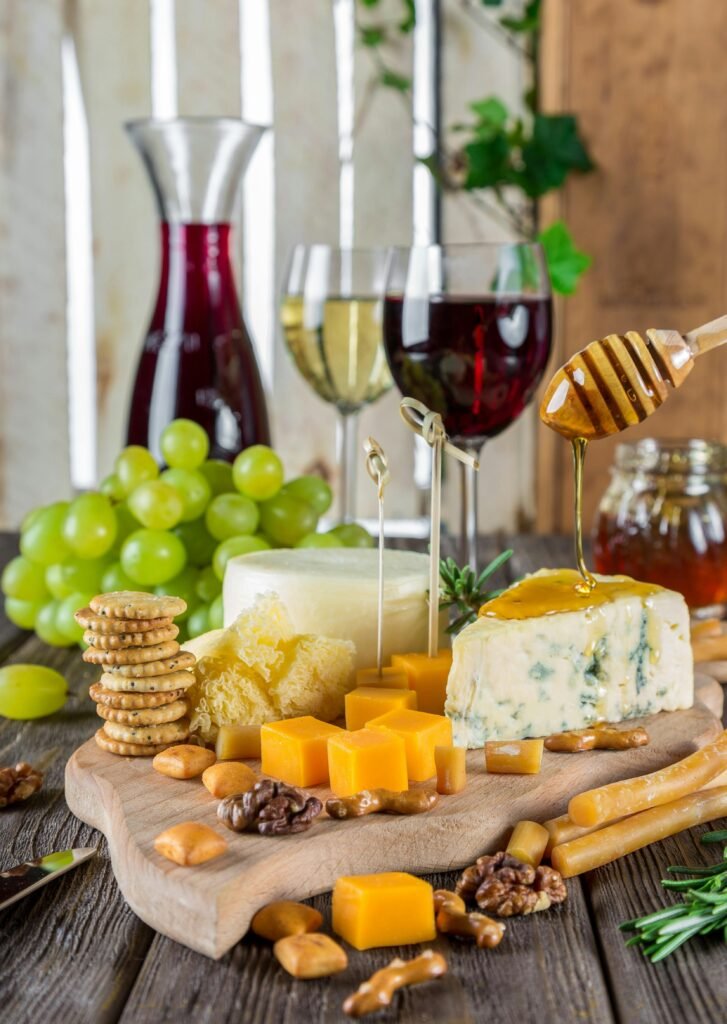Have you ever wondered about the distinction between red and white wine? It’s a question that many wine enthusiasts and novices alike ponder, and in this article, we will uncover the key differences. From the color to the production process, each type of wine offers a unique experience. So, whether you prefer the rich and bold flavors of red or the crisp and refreshing taste of white, join us as we explore the fascinating world of red and white wine.

Color
Red Wine
Red wine gets its name from the deep red color that comes from the skin of the grapes used in its production. The color of red wine can range from a light ruby red to a dark, almost black hue. The intensity of the color often indicates the richness and boldness of the wine. Red wine is known for its visually appealing and vibrant appearance, which adds to the overall experience of enjoying a glass of red wine.
White Wine
In contrast to red wine, white wine has a much lighter and paler color. White wine gets its name from the fact that it is made from grapes that have a light-colored skin. The color of white wine can range from clear and almost colorless to a pale yellow or golden hue. The color of white wine often reflects its freshness and lightness. The appearance of white wine in the glass can be quite elegant and inviting.
Grape Varieties
Red Wine Grapes
Red wine is typically made from several different grape varieties, each contributing to the overall flavor profile and structure of the wine. Some of the most popular red wine grape varieties include Cabernet Sauvignon, Merlot, Pinot Noir, and Syrah. These grapes are known for their deep, rich flavors and tannic structure, which are characteristics commonly associated with red wine. Each grape variety brings its unique set of aromas, flavors, and tannin levels, resulting in a wide variety of red wines to choose from.
White Wine Grapes
Just like red wine, white wine can also be made from a variety of grape varieties. However, white wine is typically made from grapes that have a light-colored skin. Some of the most popular white wine grape varieties include Chardonnay, Sauvignon Blanc, Riesling, and Pinot Grigio. These grapes are known for their crisp acidity and light, refreshing flavors, which make them perfect for producing white wine. Each grape variety contributes its distinct aromas and flavors, offering a diverse range of white wines to suit different preferences.
Production Process
Red Wine Production
The production of red wine involves several steps, starting with the crushing and destemming of the grapes. After the grapes are crushed, the juice, skins, and seeds are combined and undergo fermentation. During fermentation, the yeast converts the sugar in the grape juice into alcohol, resulting in the formation of alcohol and carbon dioxide.
After fermentation, the red wine is typically aged in oak barrels or stainless steel tanks to develop its flavors and aromas. Aging can vary in length depending on the desired style of the wine. Finally, the wine is clarified, filtered, and bottled for consumption. The entire process of producing red wine is carefully controlled to ensure the desired flavor profile and quality of the final product.
White Wine Production
The production of white wine differs from that of red wine in a few key ways. Firstly, white wine is made from grapes with a light-colored skin. The process begins with crushing and pressing the grapes to separate the juice from the skins and seeds. After pressing, the juice is fermented, similar to red wine, with yeast converting the sugar into alcohol.
However, unlike red wine, white wine is typically not aged in oak barrels. Instead, it is often aged in stainless steel tanks or sometimes even bottled right after fermentation. This is done to preserve the wine’s fresh and vibrant flavors. The production process for white wine aims to highlight the natural characteristics of the grape variety, resulting in a crisp and refreshing final product.
Fermentation
Red Wine Fermentation
Fermentation is a crucial step in the production of red wine. After the grapes are crushed, the juice, skins, and seeds are combined in a fermentation vessel. Red wine fermentation typically occurs at a slightly higher temperature compared to white wine fermentation. This higher temperature helps extract more color and tannins from the grape skins, which contribute to the distinctive characteristics of red wine.
During fermentation, yeast converts the sugar in the grape juice into alcohol, creating carbon dioxide as a byproduct. This process can take anywhere from a few days to a few weeks, depending on the desired style of the wine. Throughout the fermentation process, the skins are often stirred or pumped over to ensure optimal contact between the juice and the skins, resulting in a more intense color and flavor extraction.
White Wine Fermentation
The fermentation process for white wine is similar to that of red wine, but with a few key differences. As mentioned earlier, white wine is made from grapes with a light-colored skin. After the grapes are crushed and pressed, the resulting juice is transferred to a fermentation vessel, where yeast is added to initiate fermentation.
White wine fermentation typically occurs at a lower temperature compared to red wine fermentation. This lower temperature helps preserve the fresh and delicate aromas and flavors of the grapes. Fermentation for white wine is usually shorter than for red wine, lasting anywhere from a few days to a few weeks. Once fermentation is complete, the wine is typically clarified, filtered, and prepared for aging or bottling.

Tannins
Tannins in Red Wine
Tannins are an essential component of red wine, contributing to its structure, mouthfeel, and aging potential. Tannins are a naturally occurring compound found in the skin, seeds, and stems of grapes. During the red wine production process, tannins are extracted from the grape skins during fermentation. This extraction process gives red wine its characteristic astringency and contributes to the wine’s ability to age.
Tannins can be described as a drying sensation in the mouth, often accompanied by a slight bitterness. They add complexity and depth to red wine, enhancing its flavor profile. The level of tannins in a red wine can vary depending on factors such as grape variety, winemaking techniques, and aging process. Some red wines, such as Cabernet Sauvignon and Nebbiolo, are known for their high tannin levels, while others, like Pinot Noir, have a softer and more approachable tannin structure.
Tannins in White Wine
While tannins are more commonly associated with red wine, they can also be present in white wine, albeit to a much lesser extent. The tannins in white wine primarily come from contact with oak during the aging process or from extended skin contact during winemaking. White wines that have been aged in oak barrels can have subtle tannins that contribute to their structure and complexity.
However, the tannins in white wine are usually much milder and less pronounced than those in red wine. White wine tannins tend to be smoother and softer, providing a gentle grip on the palate. The presence of tannins in white wine adds texture and body to the wine, enhancing its overall mouthfeel and balance. Overall, white wine tannins are more subtle and play a supporting role in the wine’s overall composition.
Flavor Profile
Red Wine Flavor Profile
Red wine is known for its rich and complex flavor profile. The flavor profile of red wine can vary depending on several factors, including grape variety, region, terroir, and winemaking techniques. Red wines often exhibit flavors of dark fruits such as blackberry, black cherry, and plum, along with notes of spices, tobacco, leather, and sometimes floral undertones.
The level of acidity in red wine can range from light and refreshing to high and mouthwatering, depending on the grape variety and winemaking style. Red wine also typically has a warmer and fuller mouthfeel compared to white wine, partly due to its higher tannin content. The combination of these factors results in a robust and satisfying flavor experience.
White Wine Flavor Profile
White wine offers a wide range of flavors, which can vary depending on grape variety, region, ripeness, and winemaking techniques. The flavor profiles of white wines tend to be lighter and more delicate compared to red wines. White wines often exhibit flavors of citrus fruits such as lemon, lime, and grapefruit, along with notes of tropical fruits like pineapple and mango.
Another characteristic of white wine is its acidity, which can range from crisp and zesty to smooth and creamy. This acidity provides a refreshing and vibrant sensation on the palate. White wines can also showcase floral aromas, herbal nuances, and mineral undertones. Overall, the flavor profile of white wine is often described as bright, lively, and fruit-forward.

Aging Potential
Red Wine Aging Potential
Red wine is renowned for its ability to age and develop complex flavors and aromas over time. The aging potential of red wine can vary greatly depending on factors such as grape variety, winemaking techniques, and the specific vintage. Full-bodied red wines with higher tannin levels, such as Cabernet Sauvignon and Bordeaux blends, often have a longer aging potential.
During the aging process, red wines undergo chemical changes that result in the development of secondary and tertiary flavors. These flavors can include notes of dried fruits, earthiness, leather, tobacco, and spices. As the wine ages, the tannins gradually soften, allowing the other components of the wine to integrate and harmonize. Proper storage conditions, including temperature and humidity control, are crucial for the optimal aging and maturation of red wine.
White Wine Aging Potential
Unlike red wine, the aging potential of white wine is generally shorter. Most white wines are made to be consumed while they are young and fresh, as they are meant to highlight the vibrant fruit flavors and lively acidity. However, there are exceptions, and some white wines can benefit from short to medium-term aging.
White wines that have been aged in oak barrels, such as Chardonnay from Burgundy or California, can develop additional complexities and nuances with a few years of aging. The oak aging process imparts flavors of vanilla, caramel, and baking spices, adding depth and character to the wine. It’s important to note that not all white wines are suitable for aging, and it’s best to follow the recommendations of the winemaker or consult a wine expert for specific aging guidelines.
Serving Temperature
Red Wine Serving Temperature
Serving red wine at the correct temperature is essential to fully appreciate its flavors and aromas. Red wines are typically best enjoyed at slightly cooler than room temperature, although the ideal serving temperature can vary depending on the specific red wine variety. Lighter-bodied red wines, such as Pinot Noir, can be served at around 55°F (12-13°C), while fuller-bodied reds, like Cabernet Sauvignon, benefit from a slightly warmer temperature of 60-65°F (15-18°C).
Serving red wine too warm can result in an overly alcoholic and flat taste, while serving it too cold can dampen the aromas and flavors. To achieve the desired serving temperature, red wine can be stored in a wine refrigerator for a short period before opening, or it can be placed in an ice bucket for a few minutes to cool down slightly. It’s always better to serve red wine slightly cooler than desired and let it warm up in the glass, rather than serving it too warm initially.
White Wine Serving Temperature
The serving temperature of white wine is crucial to maintain its freshness and aromatic qualities. Unlike red wine, white wine is best enjoyed chilled. The ideal serving temperature for most white wines is between 45-50°F (7-10°C). This temperature range ensures that the wine’s vibrant aromas and flavors are emphasized while preserving its acidity and balance.
To achieve the perfect serving temperature, white wine can be stored in a refrigerator for a few hours before serving. If the white wine is too cold, it can be left out at room temperature or held in the hands to warm up slightly. It’s important to avoid over-chilling white wine, as excessively low temperatures can mute the flavors and aromas, resulting in a less enjoyable tasting experience.
Food Pairing
Red Wine Food Pairing
Red wine offers a wide range of pairing options, thanks to its bold flavors and structured nature. The tannins, acidity, and body of red wine make it a great companion for rich, flavorful, and fatty foods. Some classic red wine and food pairings include:
- Cabernet Sauvignon: Pair with grilled or roasted red meats, hearty stews, and strong cheeses.
- Pinot Noir: Match with roasted poultry, earthy mushrooms, and lighter cuts of pork.
- Merlot: Complement with lamb dishes, tomato-based pasta sauces, and charcuterie.
- Syrah/Shiraz: Pair with grilled meats, spicy dishes, and bold Mediterranean flavors.
Foods with high-fat content, proteins, and strong flavors often complement red wine by balancing its richness and structure. The pairing of red wine with food enhances the flavor experience of both the wine and the dish, creating a harmonious combination on the palate.
White Wine Food Pairing
White wine is incredibly versatile when it comes to food pairing, thanks to its lighter body and acidity. White wines generally pair well with lighter, milder, and delicately flavored dishes. Some popular white wine and food pairings include:
- Chardonnay: Match with seafood, roasted chicken, creamy pasta dishes, and buttery sauces.
- Sauvignon Blanc: Complement with salads, goat cheese, grilled vegetables, and light seafood.
- Riesling: Pair with spicy Asian cuisine, fruity desserts, and fresh cheeses.
- Pinot Grigio: Match with light seafood, salads, fresh vegetable dishes, and light pastas.
White wine’s acidity and freshness can help cleanse the palate between bites, making it an excellent choice for pairing with a variety of flavorful dishes. The lightness and brightness of white wine make it an ideal accompaniment to lighter, more delicate flavors found in many cuisines.
Popular Varieties
Popular Red Wine Varieties
Red wine offers a vast array of grape varieties and styles, catering to different tastes and preferences. Some of the most popular red wine varieties include:
- Cabernet Sauvignon: Known for its bold flavors and full-bodied character, Cabernet Sauvignon is one of the most widely recognized red wine varieties worldwide.
- Merlot: Merlot is loved for its approachable and fruity nature, often showcasing flavors of blackberries, plums, and chocolate.
- Pinot Noir: Pinot Noir is praised for its elegance and finesse, offering flavors of cherries, strawberries, and subtle earthiness.
- Syrah/Shiraz: Syrah, known as Shiraz in Australia, produces bold and rich wines with flavors of black fruits, spices, and hints of black pepper.
- Malbec: Originating from Argentina, Malbec produces deeply colored and robust wines with flavors of dark fruits, cocoa, and smoky undertones.
These red wine varieties have gained popularity due to their distinct characteristics and ability to pair well with a variety of dishes, making them favorites among wine enthusiasts worldwide.
Popular White Wine Varieties
White wine encompasses a wide range of grape varieties, each bringing its unique flavors and characteristics. Some popular white wine varieties include:
- Chardonnay: Chardonnay is one of the most widely planted white wine grapes, known for its versatility and ability to showcase the winemaking style and terroir.
- Sauvignon Blanc: Sauvignon Blanc is cherished for its crisp acidity, vibrant flavors of citrus, tropical fruits, and herbaceous undertones.
- Riesling: Riesling is renowned for its aromatic qualities, showcasing flavors of orchard fruits, floral notes, and distinct mineral characteristics.
- Pinot Grigio/Pinot Gris: Pinot Grigio, known as Pinot Gris in some regions, produces light and refreshing wines with delicate flavors of pear, apple, and a touch of spice.
- Gewürztraminer: Gewürztraminer is loved for its highly aromatic nature, offering exotic flavors of lychee, rose petals, and spices.
These white wine varieties have gained popularity due to their versatility, refreshing qualities, and ability to pair well with a variety of cuisines and occasions.
In conclusion, red and white wines have distinct characteristics that make them unique. Red wines offer deep and rich flavors, bold tannins, and a fuller mouthfeel, while white wines showcase vibrant and crisp flavors, refreshing acidity, and a lighter body. The choice between red and white wine ultimately comes down to personal preference and the occasion. Whether you’re a fan of the robust flavors of red wine or the refreshing qualities of white wine, there is a vast world of flavors and varieties to explore, ensuring there’s something to suit every taste. Cheers!

Franco Deville, an esteemed wine connoisseur and author, is the visionary behind “Wines of Madeira.” His extensive background in viticulture and wine tasting enriches his detailed guide on Madeira wines. Franco’s dedication to traditional winemaking and innovative approaches has established him as an influential voice in the wine community.

